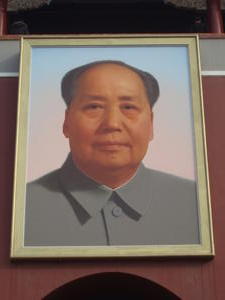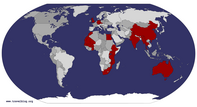Advertisement
Published: March 12th 2007

 The Chairman
The Chairman
This massive portrait of Mao hangs above the entrance to the Forbidden City. In 1989, protesters threw paint-filled eggs at the picture...but spares are kept, and a new one was speedily put up A man in his 50's was standing on the edge of the square, opposite the Great Hall of the People. He was shouting something (in Chinese, obviously) and about five cops jumped him and bundled him into a van. Another group of cops told the gathering crowd to disperse, but I tried to keep an eye on the poor geezer as he was manhandled into the police vehicle. Concerned, I sidled up to an English-speaking tour guide who was explaining the situation to his charges. 'He was probably saying bad things', he told them. ' They will just take him to the station and ask him some questions'. Yeah, we all know what
that means.
Ironically, in Chinese, Tiananmen means, 'Gate of Heavenly Peace'. Which I'm sure comes as cold confort to the families of those who met their final moments here, and in the surrounding streets, back in 1989. An eerie aura hangs over this place, and as I wandered around, I couldn't help but keep seeing that image of the lone man bravely - or foolishly - staring down that Chinese tank.

 The Great Wall
The Great Wall
The crumbling ruins of the Great Wall wind over the hills between Jinshanling and Simatai, around 100kms north-east of BeijingTiananmen Square is the focal point of Beijing, and it is truly gigantic. It is the largest public plaza in the world, measuring some 500 metres across by around a kilometre in length, and has held crowds numbering over a million on more than one occasion. During the Maoist era, the square was extended and became the symbolic heart of Chinese communism. It is lined on all four sides by monumental structures - to the bottom end, or south, lies the original front gate of the Forbidden City - Qianmen. On the west sits the rectangular, Soviet-inspired Great Hall of the People, where the Communist Party (but not the people) meets occasionally. Opposite is a similar building, which now houses the museum of the Chinese Revolution (closed for three years while that history is re-interpreted). And to the north is Tiananmen itself, the Gate of Heavenly Peace, on which is hung a massive portrait of Mao, benignly smiling down on his square and his people. In the centre of Tiananmen is Mao's mausoleum, where the Chairman's pickled corpse is put on display for a few hours each day. Just nearby is the Monument to the People's Heroes, a socialist obelisk

 The Great Hall of the People
The Great Hall of the People
Two soldiers stand guard in Tiananmen Square, opposite the building where the Communist Party rubber-stamps all of its decisions. The Party is holding its annual conference at the moment, and security is tightsurrounded by red flags. I tried to visit Mao, but sadly the big socialist gherkin is in storage while they repair the display hall over the spring and summer.
You can't help but be wowed by the pure size of Tiananmen, but as I said, it is a very spooky site. The long arm of the Communist Party is everywhere. Soldiers march around the square in pairs, or fours, or sixes; or stand guard on corners, outside buildings, and near subway entrances. Uniformed and plain clothes police maintain a heavy presence, driving across the flagstones in vans and patrol cars, checking pockets and bags, filming the crowds, and keeping a watchful eye. It feels like you are under surveillance constantly. If anybody was to even dare to unfurl a pro-democracy banner, or hold up a Falun Gong poster, they would be whisked out of there in seconds. It seems the head honchos of the People's Republic are too nervous to let the people do as they like in their square.
Heading north from the socialist monumentalism of Tiananmen, and passing under Mao's portrait, you move directly into the imperial extravagnce of the Forbidden City. So called because it

 Great Wall
Great Wall
The surrounding scenery is pretty dry and barren at this time of year, and last week's snowfalls are still just evidentwas off limits to commoners and foreigners for half a millennium, this huge complex was where the Ming and Qing emperors ruled over China from the 1300s until 1911. Beautifully preserved, it is lined on all four sides by high walls, whilst the inner compound consists of a maze of courtyards, palaces, halls and garden - ranging in size from cosy to vast. I spent four hours traipsing around, saw maybe half of the area that was opened for visitors, and then gave up. Courtyards lead into courtyards lead into courtyards. There were some fine Ming and Qing exhibits on display, as well as small galleries telling the story of China's only empress, Ci Xi, and the last emperor, Pu Yi. Perhaps the most disturbing sight, though, was a Starbucks coffee outlet, (thankfully) not marked on the outside, but serving its overpriced caffeinated drinks in the unmistakeable cups from deep within the old imperial city. I think the last emperor
and Mao would both be spinning in their respective tombs.
One of the stranger sights I visited in Beijing was the 'Underground City', which is actually just a collection of damp and dingy tunnels beneath a grimy building, a

 Long Wall
Long Wall
The Great Wall heads off over the mountains, watchtowers dotting the hilltopskilometre or so from the Square. The Commies had them built as a bomb shelter in the 1960s, when they thought the Russians were going to nuke Beijing. They were never finished, and now the complex is a museum of sorts. There isn't much to it except for the tunnels, so the owners have spiced things up with mannequins dressed in Chinese army gear, Mao posters, and Chinese 'duck and cover' style public notices, that inform civilians how to do important things like resist a sniper attack, or how to use a grenade. I went there with a couple of other tourists and we had a great time trying on the rusty PLA helmets and using the old field telephones. Perhaps the oddest thing about the tunnels is that, halfway through, you come out into a silk shop run by girls dressed in military gear, and then across the other side of the shop, you re-enter the tunnels. Weird.
A must-do when you're in the Chinese capital is, of course, the Great Wall. Beijing sports the greatest length of restored Wall sections, and they are all pretty close, as one of the major functions of the Wall was to

 Serpentine Wall
Serpentine Wall
View of the Great Wall snaking over the craggy hills into the distanceprotect China's main city. Tourists have a range of options for visiting the Great Wall, and most opt for Badaling, the famous bit that you always see on the news and in travel doccos. Tales of cable-cars and crowds and 'over-restoration' put me off a little, so I decided to go for the wilder stretch of Wall between Jinshanling and Simatai, about 100 kilometres out of town. The bonus of visiting the Wall here is that you can actually hike between the two sections, a distance of about 10 kilometres, 95% of which is on the Wall itself. I can't do justice to the magnificence of it in words, so I have attached some photos to give you an idea of what it was like. The fact that it was not totally restored gave it a real authenticity, and it fitted well with the craggy and barren mountain setting. At some points, I couldn't see another person on the Wall in either direction, which was even more magical. Definitely one of the highlights of the world so far for me.
But...to change the subject:
My whole plan with this email was to try and offer some sort of

 More Great Wall
More Great Wall
Yet another photo of the winding Great Wall at Jinshanlingopinion on what is happening in this vast and incredible country we call China. This is undoubtedly a nation undegoing a huge transformation. You can feel the change happening as you are here. Modern China is no longer the country of Mao - mobile phones, MacDonalds and Mercedes have replaced him. Consumerism has trounced communism. Beijing is fast becoming an incredibly modern city: expressways, skyscrapers, hotel, and shopping malls are springing up everywhere. The people are cosmopolitan, educated, trendy and affluent. Everything is being prepared for next August, when the world's eyes will be focused on this city, and this country.
Since the 1980s, economic liberalisation has done wonders for the eastern cities of China. Urban people are richer than they could ever have dreamed (we won't dwell on the dire poverty of the western peasants). With that wealth has come a real loosening of the strict communist moral code - socially, people are more free than at any time in Chinese history. However, the third part of the mix is missing - political freedom. People have the freedom to earn, buy and sell, but not to speak, gather or protest. All that remains of communism in China is

 Watchtowers
Watchtowers
Every few hundred metres, a watch tower or storage depot dots the wall. There are around 30 towers between Jinshanling and Simataia rather antiquated form of Stalinist political control by the Party. Information is filtered by the CCP, and dissent is not tolerated. One wonders where this will all go. Will China follow the path that many western states followed, where the growth of the middle-class will lead to calls for a more inclusive democracy? Or will it follow the likes of Singapore, where one-party rule is the price many are willing to pay for higher incomes? The voices that spoke so loudly at Tiananmen in 1989 seem to have been silenced for now. Is it money that has silenced them, or the threat of state violence? I don't know. But I wonder what the government will do if confronted with another mass protest in the next few years. What if today's student pro-democracy activists are planning a stunt for the Olympics? Would the authorities ruthlessly crush it, or just let it happen? These are questions I can't answer. But interesting ones to ponder, nonetheless.
I just hope that guy who got arrested is okay.
Thanks for reading the posts on China. I have 12 days in the UK and Germany, and then its on to Africa! Keep the

 Jinshanling Great Wall
Jinshanling Great Wall
Most of the Wall here follows the line of the hills, winding from peak to peak, offering beautiful views over the surrounding landscapecomments coming, and stay in touch...
Advertisement
Tot: 0.055s; Tpl: 0.012s; cc: 10; qc: 21; dbt: 0.0249s; 1; m:domysql w:travelblog (10.17.0.13); sld: 1;
; mem: 1.1mb



















hardeep
non-member comment
geezer
Interesting ............. looks like your having fun!